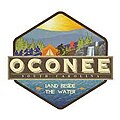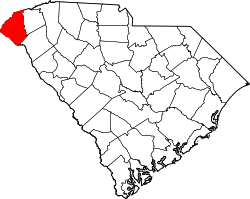Oconee County | |
|---|---|
 Oconee County Courthouse in Walhalla | |
| Nickname: Land Beside The Water | |
 Location within the U.S. state of South Carolina | |
 South Carolina's location within the U.S. | |
| Coordinates: 34°45′N83°04′W / 34.75°N 83.06°W | |
| Country | |
| State | |
| Founded | 1868 |
| Named after | Cherokee word for "land beside the water" [1] |
| Seat | Walhalla |
| Largest community | Seneca |
| Area | |
• Total | 673.57 sq mi (1,744.5 km2) |
| • Land | 626.56 sq mi (1,622.8 km2) |
| • Water | 47.01 sq mi (121.8 km2) 6.98% |
| Population (2020) | |
• Total | 78,607 |
• Estimate (2024) | 82,475 |
| • Density | 120/sq mi (45/km2) |
| Time zone | UTC−5 (Eastern) |
| • Summer (DST) | UTC−4 (EDT) |
| Congressional district | 3rd |
| Website | www |
Oconee County is the westernmost county in the U.S. state of South Carolina. As of the 2020 census, the population was 78,607. [2] Its county seat is Walhalla and its largest community is Seneca. [3] Oconee County is included in the Seneca, SC Micropolitan Statistical Area, which is also included in the Greenville-Spartanburg-Anderson, SC Combined Statistical Area. South Carolina Highway 11, the Cherokee Foothills National Scenic Highway, begins in southern Oconee County at Interstate Highway 85 at the Georgia state line.
Contents
- History
- Post-Revolutionary and 19th-century history
- Present day
- Geography
- National protected areas
- State and local protected areas/sites
- Major water bodies
- Adjacent counties
- Major highways
- Major infrastructure
- Demographics
- 2020 census
- 2010 census
- 2000 census
- Government and politics
- Economy
- Communities
- Cities
- Towns
- Census-designated places
- Unincorporated communities
- In popular culture
- See also
- References
- External links




